
|
Flamsteed Astronomy Society |
|
‘The Transits of Venus’ by Dr Robert Massey - January 9, 2012 |
|
page 2 of 2 |

|
The attempts of Le Gentil were perhaps the most unfortunate. He set sail in 1760 for India in order to observe the 1761 transit but England and France were at war and his destination, Pondichery, was overrun while he was at sea. He was only able to make some useless observations on board ship somewhere in the Indian Ocean. He stayed in the East to observe the 1769 transit but when the critical moment came there was cloud cover. By the time he arrived back in Paris he discovered that he had been presumed dead and his heirs were dividing up his estate. In 1768 Lt. James Cook was sent by The Royal Society to Tahiti, together with the astronomer Charles Green, Joseph Banks and others, on the Endeavour to make observations of the 1769 transit. Tahiti was chosen in order to have a large difference in latitude between observing stations. Unfortunately Cook’s observations were blighted by the black-drop effect, the timing errors were too great and the results were not as accurate as hoped. After Tahiti Cook’s expedition sailed in search of the undiscovered great South Continent, which he failed to find but instead charted New Zealand and became the first European to sight and claim New South Wales. Despite Cook’s attention to the health of his crew many, including Green, contracted diseases in Batavia and died during the journey home. The 1874 transit was recognised as a major scientific event and many international expeditions were mounted to make observations. Eight expeditions were sponsored by the US alone. Hundreds of photographs were taken in an attempt to reduce the errors of the timings caused by the black-drop effect but the results were uncertain to the extent of 1.5 million km. Transits of Venus are no longer important to determine the scale of the solar system which has been measured in other ways. ‘Parallax’ observations of Mars, and later the near-Earth asteroid 433 Eros, produced better results, and in modern times it is possible to use radar to measure the distance to Venus and Mars with high precision. Transits of Venus however continue to offer terrific spectacle. The most recent transit of Venus was on 8th June, 2004 and was viewed in its entirety from the UK. Many astronomers, including a team from the Flamsteed, set-up solar telescopes at the ROG and almost 1000 visitors were able to enjoy the thrilling sight from start to finish. The next transit will be on 6th June, 2012, but will only be partially visible from the UK, the best locations for viewing being Russia, Greenland, the Pacific and east Australia. Robert explained how exo-planets can now be detected by the “transit method” (or blink method) by observing the effect of planets moving in front of distant stars. When this occurs the brightness of the star reduces. The change in the light curve can be measured and the size, mass and density of any exo-planets can be deduced. To date around 700 exo-planets have been detected. This fascinating account of the Transit of Venus has surely inspired many of us to take especial interest in this year’s Transit, the more so considering that the next one will not occur until December, 2117, but it is worth noting that there will be a transit of Mercury in 2016. Our sincere thanks are due to Dr Robert Massey, not just for the lecture, but also for his responses to many questions from the audience afterwards. |

|
2004 Transit [pic: David Waugh] |
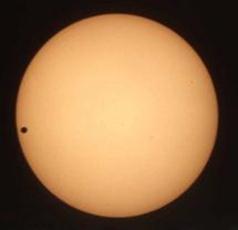
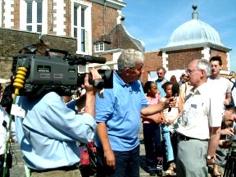
|
2004 Transit at Greenwich — Adam Hart-Davis and Eddie Yeadon [pic: Michael Bradley] |
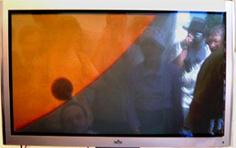
|
2004 Transit at Greenwich [pic: David Redfern] |
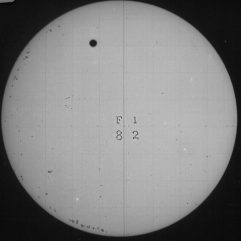
|
1882 Transit of Venus |
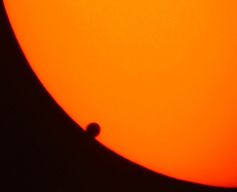
|
The "black drop effect" visible during the 2004 transit |
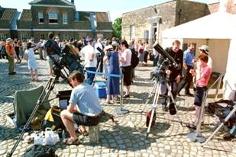
|
2004 Transit at Greenwich [pic: David Crawford] |